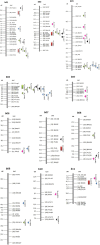A legume biofortification quandary: variability and genetic control of seed coat micronutrient accumulation in common beans
- PMID: 23908660
- PMCID: PMC3725406
- DOI: 10.3389/fpls.2013.00275
A legume biofortification quandary: variability and genetic control of seed coat micronutrient accumulation in common beans
Abstract
Common beans (Phaseolus vulgaris L.), like many legumes, are rich in iron, zinc, and certain other microelements that are generally found to be in low concentrations in cereals, other seed crops, and root or tubers and therefore are good candidates for biofortification. But a quandary exists in common bean biofortification: namely that the distribution of iron has been found to be variable between the principal parts of seed; namely the cotyledonary tissue, embryo axis and seed coat. The seed coat represents ten or more percent of the seed weight and must be considered specifically as it accumulates much of the anti-nutrients such as tannins that effect mineral bioavailability. Meanwhile the cotyledons accumulate starch and phosphorus in the form of phytates. The goal of this study was to evaluate a population of progeny derived from an advanced backcross of a wild bean and a cultivated Andean bean for seed coat versus cotyledonary minerals to identify variability and predict inheritance of the minerals. We used wild common beans because of their higher seed mineral concentration compared to cultivars and greater proportion of seed coat to total seed weight. Results showed the most important gene for seed coat iron was on linkage group B04 but also identified other QTL for seed coat and cotyledonary iron and zinc on other linkage groups, including B11 which has been important in studies of whole seed. The importance of these results in terms of physiology, candidate genes and plant breeding are discussed.
Keywords: advanced backcross breeding method; cotyledon; embryo axis; iron and zinc concentration; seed coat; use of wild beans.
Figures


Similar articles
-
Use of the advanced backcross-QTL method to transfer seed mineral accumulation nutrition traits from wild to Andean cultivated common beans.Theor Appl Genet. 2012 Sep;125(5):1015-31. doi: 10.1007/s00122-012-1891-x. Epub 2012 Jun 21. Theor Appl Genet. 2012. PMID: 22718301
-
Genetic Variability of Mineral Content in Different Grain Structures of Bean Cultivars from Mesoamerican and Andean Gene Pools.Plants (Basel). 2021 Jun 19;10(6):1246. doi: 10.3390/plants10061246. Plants (Basel). 2021. PMID: 34205241 Free PMC article.
-
QTL for seed iron and zinc concentration and content in a Mesoamerican common bean (Phaseolus vulgaris L.) population.Theor Appl Genet. 2010 Oct;121(6):1059-70. doi: 10.1007/s00122-010-1371-0. Epub 2010 Jun 9. Theor Appl Genet. 2010. PMID: 20532862
-
Biofortification of common bean (Phaseolus vulgaris L.) with iron and zinc: Achievements and challenges.Food Energy Secur. 2022 Jun 30;12(2):e406. doi: 10.1002/fes3.406. eCollection 2023 Mar. Food Energy Secur. 2022. PMID: 38440694 Free PMC article. Review.
-
Review: The potential of the common bean (Phaseolus vulgaris) as a vehicle for iron biofortification.Nutrients. 2015 Feb 11;7(2):1144-73. doi: 10.3390/nu7021144. Nutrients. 2015. PMID: 25679229 Free PMC article. Review.
Cited by
-
Genome-Wide Identification and Expression Analysis of MTP (Metal Ion Transport Proteins) Genes in the Common Bean.Plants (Basel). 2023 Sep 9;12(18):3218. doi: 10.3390/plants12183218. Plants (Basel). 2023. PMID: 37765382 Free PMC article.
-
Enhancing the Nutritional Quality of Major Food Crops Through Conventional and Genomics-Assisted Breeding.Front Nutr. 2020 Nov 26;7:533453. doi: 10.3389/fnut.2020.533453. eCollection 2020. Front Nutr. 2020. PMID: 33324668 Free PMC article. Review.
-
Genome-wide identification of the TGA genes in common bean (Phaseolus vulgaris) and revealing their functions in response to Fusarium oxysporum f. sp. phaseoli infection.Front Genet. 2023 Jan 20;14:1137634. doi: 10.3389/fgene.2023.1137634. eCollection 2023. Front Genet. 2023. PMID: 36755571 Free PMC article.
-
The Seed Coat's Impact on Crop Performance in Pea (Pisum sativum L.).Plants (Basel). 2022 Aug 6;11(15):2056. doi: 10.3390/plants11152056. Plants (Basel). 2022. PMID: 35956534 Free PMC article. Review.
-
Genome-wide association studies of mineral and phytic acid concentrations in pea (Pisum sativum L.) to evaluate biofortification potential.G3 (Bethesda). 2021 Sep 6;11(9):jkab227. doi: 10.1093/g3journal/jkab227. G3 (Bethesda). 2021. PMID: 34544130 Free PMC article.
References
-
- Ariza-Nieto M., Blair M. W., Welch R. M., Glahn R. P.(2007). Screening of bioavailability patterns in eight bean (Phaseolus vulgarisL.) genotypes using the Caco-2 cell in vitromodel. J. Agr. Food Chem. 55, 7950–7956 - PubMed
-
- Astudillo C., Blair M. W.(2008). Evaluación del contenido de hierro y zinc en semilla y su respuesta al nivel de fósforo en variedades de fríjol colombianas. Agron. Colomb. 26, 471–476
-
- Basten C., Weir B. S., Zeng Z.-B.(2001). Windows QTL Cartographer. v 1.21. Software. Raleigh, NC: Department of Statistics. North Carolina State University, USA
LinkOut - more resources
Full Text Sources
Other Literature Sources

